Trading Day: Regional markets extend sell-off on US-China trade fears
The threat of escalating US-China trade tensions pushed the market to its worst loss since October.
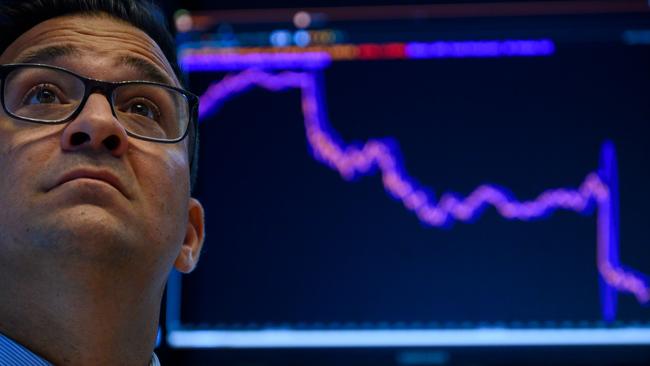
- RBA maintains optimistic forecasts
- S&P 500 futures turn positive
- PBoC fixing stronger than expected
- Technology stocks lead ASX drop
- Wall St worst losses of 2019
That’s it for the Trading Day blog for Tuesday, August 6. The local market was belted by as much as 3 per cent as trade war fears gripped global markets. Tech stocks are hardest hit, led by losses in WiseTech, Xero and Afterpay. Chinese and Hong Kong markets extended their sell-off, as the Chinese Yuan continues to trade above the key 7 level. Meanwhile, the Reserve Bank kept the cash rate at its record low of 1pc at its August meeting.
4.35pm: All sectors flash red
All sectors were seeing red on Tuesday, as global markets pulled back further in the latest escalation of US-China trade tensions.
In the local market, 11 of 12 sectors finished the session with more-than-2 per cent losses.
Trade woes dominated market movements, overshadowing the Reserve Bank’s decision to keep the cash rate on hold at its record low of 1 per cent, though the commentary helped to boost the Australian dollar to an intra-day high of $US0.6795.
Iron ore prices backtracked into a bear market, hitting local producers. BHP and Rio Tinto both clocked more than 3 per cent falls early, but recovered by the afternoon to close down 0.75 per cent and 0.11 per cent respectively.
Meanwhile, Fortescue was a standout in the sector after chief executive took the stage at mining conference Diggers and Dealers, telling reporters iron ore demand would “certainly still be up year-on-year”.
The stock finished 2.82 per cent higher to $7.29.
In financials, Commonwealth Bank lost 1.74 per cent to $79.80 ahead of the release of its full year results tomorrow morning.
Westpac lost 2.6 per cent to $27.73, ANZ wound back 2.16 per cent to $26.72 while NAB fell 2.27 per cent to $27.51.
Technology stocks were the worst hit, following the steep sell-off in US markets, where big tech stocks like Apple, Microsoft and Alphabet lost $162 billion.
Australia’s tech equivalents, the WAAAX stocks led the slide – WiseTech lost 8 per cent to $26.95, Afterpay fell 4.94 per cent to $22.34, Altium retraced by 5.41 per cent to $31.64, Appen gave back 3.61 per cent to $52.90 and Xero lost 6 per cent to $59.97.
4.16pm: Stock drop worst since Oct
Escalating US-China trade tensions have sent regional stocks tumbling on Tuesday, the local market extending its losses to $86 billion over the past two days after the US called out China for being a currency manipulator.
At the close of trade, the benchmark ASX200 was 2.44 per cent or 162.2 per lower to 6478.1, its worst daily loss since October.
Meanwhile, the All Ordinaries shed 164 points or 2.45 per cent to 6546.4.
The benchmark dropped to losses as much as 3 per cent early, after Wall Street clocked its worst session for the year.
3.35pm: Northern Mins cancels rare earth deal
Northern Minerals Ltd has terminated a rare earths supply deal signed more than two years ago with China’s Lianyugang Zeyu New Materials Sales Co Ltd, citing a breach in the agreement.
The ASX-listed company said on Tuesday the deal, which was signed in April 2017 for the supply of rare earths output from its Browns Range project in Western Australia, was ended because Lianyugang had breached the agreement. It did not give further details.
Lianyugang was to make a pre-payment of $10 million to the rare earths metal explorer under the deal, with the final value of the agreement depending on volumes delivered.
The cancellation comes amid speculation that China could cut off supplies of rare earths metals, a key ingredient in high-technology consumer electronics and military equipment, to the United States as part of the trade war.
NTU shares last down 1.56pc to 6.3c.
AAP
Ben Wilmot 3.05pm: Rural Funds halted on short attack
The listed Rural Funds Group has fired back at US-based short seller Bonitas Research after a negative report prompted a $335 million hit to the group’s value.
The stock is now in a halt until Thursday after the report from Bonitas prompted the plunge by questioning the company’s viability, saying its equity was “worthless”.
The report was launched by Glaucus Research co-founder Matt Wiechert and while he has shifted to Bonitas, his report packed significant punch. His former short-selling house Glaucus brought Blue Sky Alternative Investments to its knees.
The Bonitas report, released on Monday night, claimed the listed orchard, farm and cattle station owner had inflated its profits and conducted “nefarious” transactions with an associated management company.
RFF shares last traded down 42 per cent to $1.36.
Damon Kitney 2.55pm: Banks, lend more more money:Latitude
Latitude Financial Services chief executive Ahmed Fahour says the financial services sector needs to urgently increase capital flowing into the economy “for people to grow, spend and invest” at a time of great international financial volatility and uncertainty.
As global trade and currency issues have sent financial markets this week into a spin, Mr Fahour’s Latitude Financial Services Group has today reduced the rate of its Low Rate Personal Loans to 9.99 per cent p.a., bolstering competition and improving value for consumers.
Mr Fahour said Latitude was continuing to grow its share of the personal loans segment, recently becoming the third biggest lender of new personal loans, surpassing two of the four major banks in May and June 2019.
He said latitude’s share of new loans grew to nearly 13 per cent in June, up from just 8 per cent two years earlier.
“In the last four years, the availability of capital by all financial institutions in the personal loan space has essentially halved. As we speak today it is down 40 per cent on two years ago. I think that is a really important issue. Even one year ago it is down around 30 per cent. So the availability of capital in our country is a really big problem,’’ Mr Fahour told The Australian this afternoon.

2.52pm: RBA maintains optimistic forecasts
The RBA has flagged that it will basically maintain its economic forecasts in its quarterly Statement on Monetary Policy on Friday.
It sees domestic GDP around 2.5 per cent in 2019, rising to 2.75pc over 2020, core CPI “a little below” 2pc in 2020 and “a little above” 2pc in 2021, and unemployment falling to around 5pc over the next couple of years.
These compare with its May SOMP forecasts of GDP at 2.6pc in 2019 and 2.7pc in 2020, CPI at 2.0pc in the year to June 2020 and 2.1pc in the year to June 2021, and an unemployment rate of 4.8pc by mid-2021.
These forecasts are somewhat optimistic versus market the market consensus, which has priced in at least two more rate cuts, as assumed by the RBA.
Still, the RBA used slightly more dovish language relative to its July statement, noting its preparedness to “ease” if needed rather than just “adjust”, as it said last month.
And the RBA is unlikely to be satisfied with and unemployment rate of “around 5pc”, given its recent analysis that the non-accelerating inflation rate of unemployment has fallen to 4.5pc.
AUD/USD hit an intraday high of 0.6795 but the unemployment forecast suggests more stimulus (either monetary or fiscal), will be needed beyond market pricing for a cash rate below 0.5pc by March 2019.
2.30pm: RBA keeps rates unchanged
Australia’s Reserve Bank has kept the cash rate at record lows of 1 per cent at its August meeting, but said it will ease monetary policy further if needed.
The Aussie dollar has edged higher on the news, last at US67.95c, while the ASX200 is holding is 2 per cent loss to 6506.1.
2.04pm: Dulux, Nippon scheme effective
Nippon Paint’s $3.8 billion takeover of Dulux has today become effective, with Dulux shares to be suspended from trade at the close of trade today.
In a notice to the market this afternoon, Dulux said it had lodged its court approval with ASIC, making the scheme of arrangement effective from today.
Shareholders on the register on August 14 will be eligible to receive $9.37 per share, to be paid on August 21.
DLX last traded up 0.11pc at $9.36.
1.56pm: S&P 500 futures turn positive
US S&P 500 index futures have just turned positive after falling as much as 1.9 per cent intraday, helping Australia’s S&P/ASX 200 to an intraday high of 6640.3.
The market is still down 2.2pc after falling 3pc intraday, but it’s tempting to see the 2-month low of 6444.4 low as a durable bottom.
That’s because it quickly regained the 10-day moving average at 6452.
The 100-DMA has held on daily closing basis since 21st January.
It’s also worth noting the bounce off the 200-DMA on S&P 500 futures.
It suggests that the physical market will hold the 200-DMA tonight at 2790.
1.51pm: Fortescue reverses on Diggers speech
Fortescue Metals has reversed early losses, and is defying weakness across its bulk mining peers, after presenting to the Diggers and Dealers conference in Kalgoorlie.
Chief executive Elizabeth Gaines said the miner continues to see strong iron ore demand despite current price volatility.
FMG shares are trading higher by 1.13 per cent to $7.17, after an earlier 7 per cent fall to $6.59.
Peers BHP and Rio Tinto are trading lower by 0.75pc and 0.69 per cent respectively.
1.37pm: Current account surplus on the cards: CBA
The June trade balance posted a record surplus of $8.036 billion, setting expectations for a second quarter current account surplus, the first since Q2 1975.
A surging iron ore price in June helped to deliver the very strong trade result, alongside weak imports as domestic demand softens.
Commonwealth Bank senior economist Belinda Allen says the rise in net exports is expected to boost Q2 GDP growth by 0.4 percentage points, pushing the current account into surplus at $1.4bn or 0.3pc of GDP and those large surpluses shoudl continue.
“Escalating trade tensions between the US and China are the main downside risk to Australia’s external sector performance in coming months,” she notes.
“Most Australia’s exports to China stay in China, providing some protection to Australia from US-China trade tensions. We are exposed to the Chinese domestic economy which should be a beneficiary of actual and prospective Chinese policy stimulus.”
[REPORT] Australia has recorded an 18th consecutive monthly trade surplus https://t.co/TflUyic595 #ausbiz #ausecon #trade pic.twitter.com/AvStRj42Sq
— CommSec (@CommSec) August 6, 2019
Sarah-Jane Tasker 1.23pm: CropLogic jumps on $US15m deal
It’s not all carnage on the Australian market today with CropLogic in the green after announcing a $US15 million ($22m) supply deal with a US company.
The Australian-listed agtech company said today that it had executed a supply agreement with Deschutes Labs, a new industrial hemp processing facility located in Central Oregon, US.
Shares in the company are 11.5 per cent higher at 8.7c on the news.
“This supply agreement establishes CropLogic as a viable producer and assists in developing credibility amongst other hemp farmers that we are pitching to,” CropLogic chief executive James Cooper-Jones said.
Anthony Vivolo, manager of Deschutes Labs, said his company’s mission was to produce the highest quality hemp extracts and isolates from premium American grown industrial hemp.
“Through our relationship with Croplogic, a growing partner offering vast knowledge in hemp genetics, we can offer our customers consistent and abundant CBD products,” he said.
CropLogic said it had successfully planted 500 acres of CBD producing hemp biomass and has embarked on a joint venture program to grow an additional 16.6 acres of premium trimmed flower hemp.
The supply agreement announced represents less than 30 per cent of its production estimate.
CropLogic said the agreement was for the supply of biomass in weekly allotments beginning 20 October 2019. Payment in US$ will follow each delivery and provided these deliveries are completed the total supply agreement value is about $15m.
1.07pm: China likely unfazed by manipulator tag
An official designation of China as a “currency manipulator” from the US has no real implication for China but serves only to escalate the trade tensions, according to ANZ head of Asia Research Khoon Goh.
The US Treasury this morning confirmed the label, foreshadowed by a number of tweets from President Trump, under the 1998 Omnibus Trade and Competitiveness Act last used on China between May 1992 and December 1994.
Mr Goh notes that under this act action for now involves engagement with the IMP, but “it is not entirely clear what the IMF could do”.
He says China is unlikely to be too concerned by the label, since the US has already imposed heavy tariffs on its imports and is set to impose more from September 1.
“More engagement with the US over its currency policy will be as fruitful as the trade negotiations thus far. Instead, China is allowing the yuan to be more market determined, after artificially suppressing weakening pressure since last year,” he says.
“While the latest action by the US will not have major repercussions for China, it is a further escalation which will negatively impact on market sentiment. The damage from that is more significant than the actual labelling itself.”
1.05pm: Pinnacle defies market rout
Pinnacle Investment Management shares have jumped as much as 8.5 per cent after a 30.1 per cent increase in full-year profit.
The equities manager says profit for the 12 months to June 30 rose to $30.5 million, with funds under management increasing 42.9 per cent from a year earlier thanks to a mix of organic growth and acquisitions.
Pinnacle lifted its final dividend 2.3 cents to a fully franked 9.3 cents and its shares soared against the backdrop of a widespread sell-off in the broader Australian market.
At lunch, they were still 5.69 per cent higher at $4.09, compared with a 2.39 per cent fall for the ASX All Ordinaries.
“Pinnacle continues to deliver on the medium-term mission described to shareholders when it became a pure-play funds management group in 2016,” chair Alan Watson said.
AAP
Richard Gluyas 12.55pm: Westpac transparency ‘game changing’
Westpac has changed the game on transparency of mortgage advertising, according to JP Morgan analysts.
In a move that addresses some of the competition regulator’s concerns about the opaqueness of the mortgage market, Westpac has switched its multi-tiered pricing structure based on loan size to a single-tier discount on the standard variable rate for mortgages above $150,000.
The bank said last month that a 1.29 per cent discount to the SVR would apply to its premier advantage package from July 22.
Previously, Westpac had four different offers for the same package, ranging from discounts of 60 basis points to 90 basis points depending on the tier.
“We don’t view this as a genuine increase in discounting but an improvement in transparency, with advertised rates now reflecting more realistic discounts,” lead analyst Andrew Triggs said in a report.
Mr Triggs said the initiative was long overdue and good for customers.
Further measures were likely to be introduced to reward customer loyalty.
12.37pm: WAAAX dominates worst performers
High-growth WAAAX stocks are the top five worst performers at lunch, as the tech sector is hardest hit by the broad regional sell-off.
It comes as investors turn risk-averse and after Nasdaq dropped 3.5 per cent overnight, with futures suggesting the index could fall a further 1 per cent in tonight’s session.
WiseTech shares are lower by 7.37 per cent to $27.14, market darling Afterpay is trading down 6.4pc to $22, Altium is losing 4.75pc to $31.86 while Appen is down 5.77pc to $25.32 and Xero is 7.63pc lower to $58.92.
At these levels, the technology benchmark has shed 9.5 per cent in just the past two days.
12.22pm: Yen recedes as currency war fear fades
Fears of an all-out currency war are subsiding on Tuesday, as indicated by a pull back in the Japanese yen.
Yesterday, the currency soared, in a similar manner to gold stocks, amid a rush to safe haven assets but today’s PBoC fixing has prompted the Japanese currency to fall against all of its Group-of-10 peers, the USDJPY last at 106.1.
Joyce Moullakis 12.13pm: Regional banks face dividend cuts: MS
Bendigo and Adelaide Bank and Bank of Queensland face potential dividend cuts over the next 12 months, Morgan Stanley analysts have warned.
The analysts reduced their earnings and price targets on both stocks today citing headwinds to their businesses and margins caused by lower interest rates.
“The impact is faster at Bendigo, while BoQ faces more deposit pricing pressure. What’s more, both banks are facing dividend cut risks in next 12 months,” analysts led by Andrei Stadnik said.
On Bendigo, Morgan Stanley expects the bank’s net interest margin to fall two basis points in the second half of fiscal 2019. Bendigo reports its full year earnings results on Monday.
“While we think BEN will maintain its dividend at this result, a dividend cut is a risk in FY20E (payout ratio >85%) unless loan losses continue to surprise on the downside,” the report said.
The outlook for BoQ in Morgan Stanley’s view was only slightly better on “valuation grounds”.
BEN shares last down 2.63pc to $10.75, while BOQ is down 1.83pc to $8.85.
12.10pm: Malaysia to extend Lynas licence
Malaysia plans to extend Lynas Corp’s licence to operate a rare earths processing plant, though it could be for a shorter duration than the usual three years, two sources with direct knowledge of the matter say.
The Australian company has been running the plant in Malaysia since 2012 using rare earths mined from Mount Weld in Western Australia, despite a dispute over the removal of low-level radioactive waste produced by the plant. A decision to extend the licence by a September 2 deadline is important for the market for rare earths, as Lynas is the biggest producer outside China. Beijing has in the past tightened supply of the materials, used in everything from military equipment to high-tech consumer electronics.
Lynas shares were up as much as 7.1 per cent to $A2.72 in morning trade on Tuesday, roughly wiping out Monday’s losses on the back of a reported hurdle to its Malaysian plant’s licence extension.
Reuters via AAP
11.43am: Here’s what we know this morning
Its been a wild session on the ASX this morning, with heavy US falls pulling the benchmark ASX200 to as much as 3 per cent losses early.
Ahead of lunch, here’s how markets are trading:
- ASX has recovered some ground, last down 155 points or 2.33 per cent to 6485.4
- At these levels, $83 billion in value has been wiped off the ASX over the past two days
- China’s Shanghai Composite is lower by 1.86pc, while the Hang Seng is lower by 2.05pc
- The Chinese yuan is trading at 7.0490 against the dollar onshore, while the offshore remnimbi is at 7.0829 after spiking to 7.133
- The Aussie dollar is higher by 0.41 per cent to trade at US67.84c
In equities, here are the top 5 best performers:
- Pinnacle, up 7.49pc to $4.16
- Lynas, up 7.09pc to $2.72
- St Barbara, up 3.52pc to $5.76
- Regis Resources, up 2.67pc to $5.76
- Bingo Industries, up 2.47pc to $2.29
And the worst 5:
- Xero, down 7.54pc to $58.98
- NRW Holdings, down 7.27pc to $2.04
- Appen, down 7.18pc to $24.94
- WiseTech, down 7pc to $27.25
- Altium, down 6.7pc to $31.21
11.43am: Trade surplus beats estimates
Australia’s trade balance recorded a $8.036B surplus for June, significantly stronger than Bloomberg’s consensus estimate of $6.000B.
Further sweetening the trade date, May was revised up to a $6.173B surplus from $5.745B first reported.
AUD/USD rose further from 0.6782 to 0.6792 but the trade data are somewhat redundant.
The re-escalation of the trade war threatens to hurt Australian exports via slower global economic growth.
Australia's trade balance in June surged to a new record high of $A8.036bn (exp $6.0bn, prior rev $6.17bn from $5.75bn).
— James Foster (@JFosterFM) August 6, 2019
Value of exports up by 1.4% in the month and 15.5% on the year. Imports fell by 3.6%m/m and -1.3%Y/Y. #ausbiz pic.twitter.com/OZTZhSfqVK
Paul Garvey 11.35am: Oil, gas stocks drag on double blow
Australian oil and gas stocks are copping a punishing after the one-two punch of China economic turmoil and gas reservation rhetoric out of Canberra.
Origin Energy and Santos – the two local companies most exposed to Canberra’s latest overtures about domestic gas intervention – are down 4.6 per cent and 4.3 per cent respectively, making them the worst-performed of the ASX-listed oil and gas producers.
But other producers are also copping it. Woodside Petroleum is down 3.1 per cent, Oil Search has fallen just over 4 per cent, Cooper Energy is 3.5 per cent weaker and Senex Energy has fallen 3.1 per cent.
Oil prices have fallen more than 7 per cent in the past week on the back of renewed trade war tensions between China and the United States, which have stoked concerns about a slowdown in the global economy.
Those China-US economic tensions have overshadowed Iran’s seizure of three oil tankers in the Strait of Hormuz.
11.27am: PBoC fixing stronger than expected
China’s currency was stronger than expected, supporting the Australian dollar and shares ahead of the open of key Chinese and Hong Kong markets.
PBOC set its yuan reference rate at CNY6.9683, well below prevailing offshore yuan levels above CNY7.10.
The yuan fixing was also stronger than Bloomberg’s consensus estimate of CNY6.9871.
AUD/USD hit an intraday high of 0.6784, bouncing off an almost decade low of 0.6750 (apart from the January 2019 “flash-crash” low).
The S&P/ASX 200 share index hit a post-open intraday high of 6492, but remains down 2.3pc.
S&P 500 futures have set the pace, down 0.6pc now after falling 1.9pc in early Asian trading.
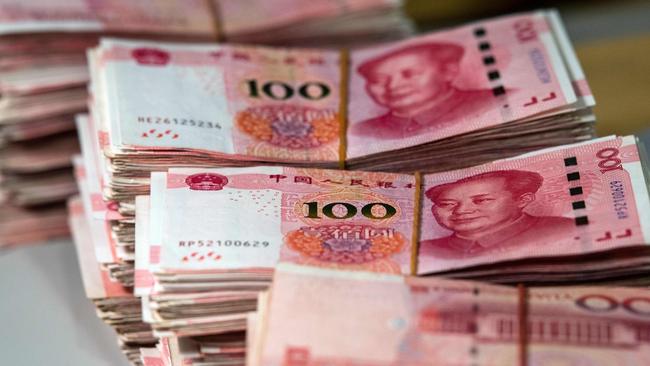
Eli Greenblat 11.25am: Myer falls below 50c amid retail sell-off
Myer shares have been hit hard by the global rout on sharemarkets, falling below 50 cents for the first time since March.
Shares in Myer were down almost 7 per cent to 47.5 cents this morning.
Other retailers sold heavily lower include Harvey Norman down 4 per cent, Wesfarmers down 2.5 per cent, Woolworths down 2.3 per cent and Coles weaker by 2 per cent.
Billionaire Solomon Lew’s Premier Investments, which is Myer’s biggest shareholder, was down 3.5 per cent today and JB Hi-Fi is down 2 per cent.
11.12pm: ASX holds support line for now
Australia’s S&P/ASX 200 share index found intraday support after falling as much as 3pc to an 8-week low of 6444.4.
While it briefly punctured its 100-day moving average for the first time since January, it soon regained this line, now at 6452.6.
It came as S&P 500 futures found support from its 200-DMA - it’s currently down about 0.9pc after falling as much as 1.9pc in Asian trading.
Focus now turns to China’s currency fixing at 1115 AEST and its sharemarket opening at 1130 AEST.
The extent to which the PBOC validates the overnight move in USD/CNH to 7.14 will be key for sentiment.
Attention then turns to the RBA interest rate decision at 1430 AEST.
S&P/ASX 200 last 2.6pc at 6471.
Zoe Samio 11.09am: Southern Cross dips on outsourcing
Southern Cross Media shares are trading lower by 3.15 per cent since this morning’s announcement it would book a loss of $9.2 million from the sale of its broadcast transmission assets.
As part of the sale agreement, BA will manage and maintain more than 500 radio and TV transmission services around Australia for an initial term of 15 years.
Southern Cross chief technology officer Stephen Haddad said the outsourcing is a “logical step” for the company, which operates 80-plus radio stations across its Triple M and Hit Networks, and consistent with its strategy.
SXL shares last down 3.15pc to $1.23.
11.02am: Rural Funds hit by short report
Rural Funds Group has been targeted in a short report, with claims the group fabricated rental income and inflated its financial performance.
Shares in the company have been hit by 42 per cent in the first hour of trade, to more-than three year lows of $1.36.
The REIT, which owns a portfolio of agricultural assets leased to agricultural operators, has been targeted by Bonitas Research, with claims that management was siphoning its assets into its privately held business.
“We think it to be in the best interest of RFF minority shareholders to immediately commence an independent investigation into RFF’s reported rental income from its two largest third-party lesseess and into its two recent transactions that appear solely to benefit RFF Management’s private holdings,” the report reads.
Ben Wilmot 10.49am: Aveo, Brookfield in final talks
Retirement village company Aveo has revealed that Canadian giant Brookfield is in final talks to take over the company at close to $2.20 per share as it edges closer to striking a privatisation deal.
The group’s shares jumped to close to the offer price, which is above last night’s close of $2.03 but falls well short of the group’s net tangible asset backing, in early trade.
Aveo has disclosed that it is undertaking a scheme of arrangement, and reports have indicated that 24.4 per cent shareholder Mulpha will participate in the take over, likely taking an interest in an unlisted vehicle.
Aveo, the country’s largest independent retirement operator, said that “commercial negotiations” had continued with the preferred party, Brookfield Property Group, since they were announced on July 22.
Aveo shares jumped 6 per cent to $2.165 in early trading, but have succumbed to the market weakness, last down 2.22pc.

10.38am: Magellan inflows continue
Hamish Douglass’ globally focussed Magellan Financial continues to generate net inflows, with July flows of $574 million.
This is made up of retail inflows of $349 million and net institutional inflows $225 million.
July total funds under management at period end $89.7 billion, which is up 3.5 per cent month on month.
At the end of June Magellan’s tops holdings were Microsoft (7.3pc of fund), Facebook (6.7pc) Visa (5.9pc) Starbucks (5.8pc) Alphabet (5.7pc) and Apple (5.4pc).
The stock hasn’t been immue to today’s sell-off, last down 2.73 per cent to $57.08 after recently reaching an all-time high of $62.60.
10.36am: Gold shines amid market sell-off
Gold prices surged to the highest in more than six years amid intensifying US-China trade war which has boosted demand for so-called safe havens.
China on Monday hit back at Donald Trump’s tariff threat by allowing its currency - the yuan to slip.
Bullion has risen about 15 per cent this year. Spot gold last traded at $US1473.68 an ounce, up $US9.98.
Local gold miners are cheering the moves - dominating the markets top performers early.
St Barbara is adding 5.69pc, Northern Star is up by 5.56pc, Resolute Mining is up by 4.9pc and Saracen rounds out the top 5 with a 4.64pc gain.
10.23am: Technology stocks lead ASX drop
The Australian market is a sea of red at the open, tumbling as much as 3 per cent in opening trade, but technology shares are well and truly leading the downfall.
The sector is lower by 6 per cent, led by weakness in the key WAAAX stocks.
WiseTech is lower by 8.6 per cent to $26.78, Afterpay down by 6.4 per cent to $22, Altium is losing 7 per cent to $31.11, Appen down by 9.2 per cent to $24.41 and Xero down by 7.84pc to $58.79.
Nearmap is lower by 9pc to $2.74.
ASX200 is down 2.7 per cent to 6461.3.

10.18am: Asian markets tumble
Tokyo stocks opened nearly three per cent down after Wall Street suffered the worst sessionof the year on worries about an escalating US-China trade war.
The benchmark Nikkei 225 index fell 2.94 per cent or 609.00 points to 20,111.29 in the first few minutes while the broader Topix index was down 2.87 per cent or 43.24 points at 1,462.64.
AFP
10.08am: Early drop eclipses yesterday’s fall
The local market has eclipsed yesterday’s falls in just the first 10 minutes of trade, falling 2.82 per cent or 187 points to 6453.1.
That’s in addition to yesterday’s $39 billion sell-off, and amid US calls that China was a “currency manipulator”.
Traders will be awaiting the Chinese open at 11.30am.
9.54am: Centuria posts $89m profit
Centuria Industrial REIT has posted a statutory profit of $88.8 million for the financial year, a slip of $10m from the previous year but a boost to distributable earnings.
Releasing its full year results, the company said its distributions per unit ws 18.4 cents, in line with guidance.
Over the year, its total assets increased to $1250.2 million, after the acquisition of 6 assets for $147.4m, as well as revaluation gains of $72m driven by its NSW and VIC portfolios.
“The REIT’s quality improved and financial results were delivered in line with the guidance provided. Strategic transactions that have continued to grow the REIT will introduce quality, complimentary assets to the portfolio that will be relevant to our key tenant customers,” head of funds management Ross Lees said.
9.47am: Economic gloom hits confidence
Consumer confidence fell at the weekend as a gloomy mood about the economy appeared to take hold, according to an ANZ survey.
The ANZ-Roy Morgan Australian Consumer Confidence index dropped 2.3 per cent from the previous week, with respondents’ perception of the economy, including the outlook for the next 12 months, tumbling 6.1 per cent, although sentiment about conditions during the next five years improved 3.8 per cent.
The weekly measure of consumer mood, which is based on about 1,000 face-to-face interviews conducted on Saturdays and Sundays, recorded a 4.3 per cent fall in how people felt about their financial condition compared with a year ago and a 1.9 per cent dip regarding their finances over the next year.
AAP
ANZ Roy-Morgan confidence lower on trade dispute and equity weakness. Still above average. https://t.co/wjGtfbgRoR
— David Plank (@DavidPlank12) August 5, 2019
9.32am: Futures suggest bleak session ahead
Trade war fears have shaken global markets overnight, and are set to prompt more significant falls on the local benchmark after it notched its worst fall for the year yesterday.
Futures relative to fair value suggest an early drop of 1.6 per cent, with more downside risk as futures track 3.34 per cent lower just before the open.
It comes after the PBoC set its yuan fix above expectations, and sent the USDCNY above its key 7.00 level, what US president Donald Trump was quick to call out “currency manipulation”.
“Allowing for yuan depreciation is an offsetting force against the economic impact from US tariffs, but this action does come at a cost,” NAB’s Rodrigo Catril.
“For one as we have seen overnight, the sharp depreciation of the yuan has triggered a sharp sell off across risk assets, including China’s equity market, heightening concerns over China’s capital outflows and its destabilising impact on the economy. President Trump also didn’t waste too much time hitting his tweeter account accusing China of currency manipulation while also calling on Fed to do more.”
Those moves prompted a run to safe haven assets - US 10-year yields dropped by 12.9 basis to 1.7159pc, while the Australian 10-year yield fell to as low as 0.975pc, last at 0.986.
“Market expectations of easier Fed policy have ramped up, with the Fed Funds rate currently priced at a low of 1.03pc, so that’s at least four cuts, with half a chance of five further rate cuts by the end of next year – the market taking a clear view that the so-called “insurance” easing will morph into a full-scale easing required to ward off a US economic recession,” Mr Catril added.
Gold jumped to a 6-year high, while iron ore futures on the Singapore exhange fell 8.6pc to close at $US94.32 per tonne.
Eyes are also on the RBA today, with expecations that governor Phillip Lowe will keep rates steady at 1pc.
ASX200 last at 6640.3. AUDUSD lst at 0.6765.
9.29am: What’s impressing analysts, what’s not
- Credible Labs cut to Speculative Hold, price target cut 17pc to $2.30 - Bell Potter
- Iluka raised to Buy - Mornginstar
- Mineral Resources raised to Buy - Mornginstar
- Perpetual price target cut 6.3pc to $35.60 - Morgan Stanley
- Reliance Worldwide cut to Equal-weight, price target cut 25pc to $3.75 - Morgan Stanley
- Rio Tinto PLC raised to Buy - DZ Bank
9.15am: BWP boosts dividend after site offloads
BWP Trust, landlord of Bunnings, has reported a 7 per cent slip in net profit for the year, but declared a 1.56 cents per unit special distribution after a series of divestments.
For the year to June, net profit was reported at $169.4 million, down from $183.1m in the previous but a total distribution of 18.11 cents, up from 17.81 in 2018.
The Trust said the offload of some Bunnings sites was ‘inevitable with the ongoing evolution of the Bunnings business model”, and that re-formatting of two vacated properties had been completed over the year, with another three in the works.
It sold four properties over the year for $72 million but did not make any new buys.
“While the Trust continued to seek to grow the asset portfolio during the year, investment opportunities with good potential for value creation were difficult to find, and consequently no new assets were acquired,” it said.
9.08am: ANZ in pay overhaul
ANZ has overhauled how staff will be rewarded, dropping individual bonuses for the majority of employees for an incentive based on the overall performance of the company.
It is the first sweeping change in pay structure by one of Australia’s big banks following a government-ordered probe last year of misconduct in the country’s financial industry.
In a statement, ANZ said that from October the only variable bonus that most employees will receive will be in the form of a group performance dividend that would be based on the bank’s performance on factors including risk, financial, customers and reputation. The change won’t apply to the bank’s executive committee, whose pay is structured based on regulatory requirements.
ANZ said the change won’t affect how much is spent on total remuneration, though the mix between fixed and variable bonuses will change.
Staff rewards was one of 16 initiatives that ANZ in February said it would tackle in response to recommendations made by the royal commission. ANZ previously removed individual financial targets for staff in bank branches to address concerns about the impact of pay on conduct within banks.
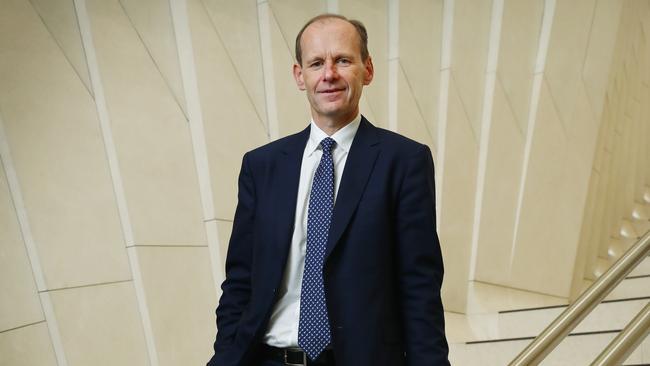
Dow Jones
9.01am: ASX futures down more than 200 points
A drop on US markets is set to hit home hard, likely to send the benchmark ASX to triple-digit losses at the open.
Overnight, Wall Street had their steepest percentage drops of the year, the Dow Jones shed 767 points or 2.9 per cent, while the S&P 500 lost 2.98 per cent and the tech-heavy Nasdaq lost 3.47pc.
Those pressures are pushing on ASX futures in the lead up to the open, last down 223.5 points or 3.34pc.
8.52am: Acquistions weigh on SCA profit
Shopping centre operator SCA Property Group has posted a 37 per cent drop in profit after a a $678 million spending spree over the year, as well as reduced valuation uplift.
One of the first Australian companies to report its full year results, the company today said its statutory net profit after tax ws $109.6m down, 37.4pc on the previous year but that funds from operations was up by 24.1pc on the previous to $141.8m.
Over the year, the company has completed 12 convenience-based acquisitions, including 10 centres from Vicinity group, and maintained occupany of 98.5pc across the rest of its portfolio.
“The acquired centres are performing in line with our strategy and expectations at the time of acquisition. We are continuing to work toward improving the performance and value of these centers by applying our expertise in convenience-based shopping centres to improve tenancy mix, set sustainable rents and achieve cost efficiencies,” chief executive Anthony Mellowes told the market.
The company guided for funds from operation for FY20 at 16.7 cents per unit, 2.3pc above its FY19 result.
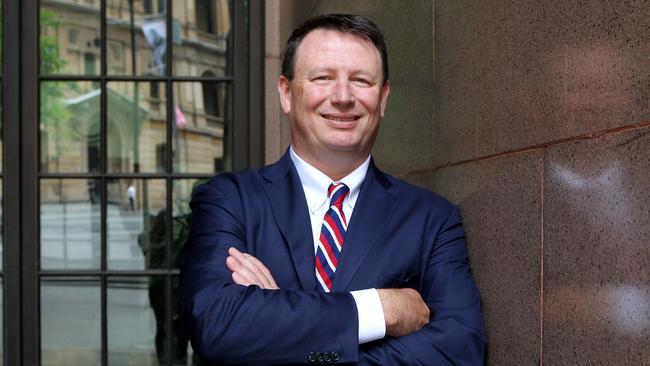
8.46am: Southern Cross to outscource transmission
Television and radio broadcaster Southern Cross Media will start the process of outsourcing its transmission services in the weeks ahead, a move set to drag on its books by $9.2 million in the current year.
In a notice to the market this morning, the former Macquarie Media group said its television and radio transmission services would be outsourced to Broadcast Australia, the long-term provider for the ABC and SBS.
The transaction will result in a non-cash loss of $9.2 million from the sale of its current broadcast transmission assets to BA.
“The outsourcing is a logical step for SCA, consistent with the group’s strategy of delivering content and media platforms and moving away from asset intensive activities that can be delivered by specialist service providers,” chief technology officer Stephen Haddad told the market.
8.00am: China ‘a currency manipulator’
The US Treasury Department has designated China as a currency manipulator, after the yuan’s value against the dollar fell below a “line in the sand” and intensified trade tensions.
In a statement, the Treasury Department said Secretary Steve Mnuchin, “under the auspices of President Trump,” has determined that China is a currency manipulator.
“As a result of this determination, Secretary Mnuchin will engage with the International Monetary Fund to eliminate the unfair competitive advantage created by China’s latest actions,” the department said.
China’s currency weakened yesterday, trading at more than 7 yuan per US dollar for the first time in more than a decade. The perceived willingness by China to use the yuan as a trade weapon led to a huge selloff on Wall Street, with the Dow Jones Industrial Average and S&P 500 falling almost 3 per cent, while the tech-heavy Nasdaq Composite slid 3.5 per cent.
Dow Jones
China is intent on continuing to receive the hundreds of Billions of Dollars they have been taking from the U.S. with unfair trade practices and currency manipulation. So one-sided, it should have been stopped many years ago!
— Donald J. Trump (@realDonaldTrump) August 5, 2019
7.50am: Gold jumps
Gold surged 2.0 per cent overnight to its highest level in more thansix years as a worsening US-China trade conflict prompted investors to dump riskier assets for safe havens, with a weaker US dollar supplying additional fuel for bullion’s run.
Spot gold was up 1.7 per cent at $US1,464.72 per ounce after hitting its highest level since May 2013 at $US1,469.60.
US gold futures settled 1.3 per cent up at $US1,476.50.
Reuters
7.40am: Oil falls 3pc
Global oil benchmark Brent futures fell more than 3.0 per cent overnight on global growth concerns after US President Donald Trump last week threatened China with more tariffs, which could limit crude demand from the world’s two biggest buyers.
Brent crude fell $US2.08, or 3.36 per cent, to settle at $US59.81 a barrel. US West Texas Intermediate (WTI) crude futures fell 97 US cents, or 1.74 per cent, to settle at $US54.69 a barrel, finding some support from a draw in inventories at the Cushing, Oklahoma, storage hub and delivery hub for WTI.
Stocks at Cushing fell nearly 2.4 million barrels in the week toAugust 2, traders said, citing data from market intelligence firm Genscape. WTI’s discount to Brent narrowed to $US5.15 a barrel, its narrowest since July 2018.
Both crude benchmarks plummeted by more than 7.0 per cent last Thursday to their lowest level in about seven weeks after Trump’s announcement, before recovering somewhat to leave Brent down 2.5 per cent on the week and US crude 1.0 per cent lower.
Reuters
7.20am: ASX set to dive at open
The Australian share market is expected to open sharply lower after significant losses on Wall Street overnight.
At 7am (AEST) the SPI200 futures contract was down 110 points, or 1.67 per cent, at 6,460.0, suggesting an early slump for the benchmark S&P/ASX200.
The three major indices on Wall Street had their steepest percentage drops of the year overnight, with Dow Jones Industrial Average finishing down 2.9 per cent, the S&P 500 down 2.98 per cent and the tech-heavyNasdaq Composite down 3.47 per cent.
The Reserve Bank of Australia will announce its decision on interest rates at 2.30 pm (AEST).
The Aussie dollar is buying US67.55 cents from US67.71 cents yesterday.
AAP
6.50am: Wall St suffers worst losses of 2019
Wall Street stocks plunged after a forceful response by Beijing to the latest US tariffannouncement escalated an ongoing trade war, exacerbating global growth worries.
The Dow Jones Industrial Average sank 2.9 per cent or around 770 points to 25,717.74 in the worst session of the year.
The broad-based S&P 500 slumped 3.0 per cent to 2,844.74, while the tech-rich Nasdaq Composite Index tumbled 3.5 per cent to7,726.04.
After yesterday’s local share rout, the ASX is set to dive at the open. At 6.55am (AEST) the SPI futures index was down 102 points, or more than 1.5 per cent.
US stocks opened sharply lower after China’s currency tumbled below 7.0 against the dollar, seen as a retaliatory step after US President Donald Trump announced last week he would impose 10 per cent tariffs on $US300 billion in Chinese imports.
Stocks pushed lower following weak US services sector data and went lower still after Chinese state media reported that Chinese firms have stopped buying US farm produce.
China’s purchase decision means more pain for the US agricultural sector, which could hit the farm states that helped electTrump in 2016.
Analysts offered a range of views on whether Monday’s moves by Beijing will lead to further tit-for-tat moves.
Chris Krueger, a Washington strategist at Cowen, an investment bank, said of China’s rebuttal, “on a scale of 1-10, it’s an 11,” compared with other possible measures.
The actions “seem designed for maximum political impact,” he said. “We expect a quick (and possibly intemperate) response from the White House and consequently expect a more rapid escalation of trade tensions.”
But other analysts noted has sometimesnot gone ahead with such measures, alluding to reports that the latest tariff announcement was opposed by some key White House aides.
“Negotiations will continue to take place,” said Alan Skrainka of Cornerstone Wealth Management. “What we’re seeing is hardball negotiations playing out in the public eye.”
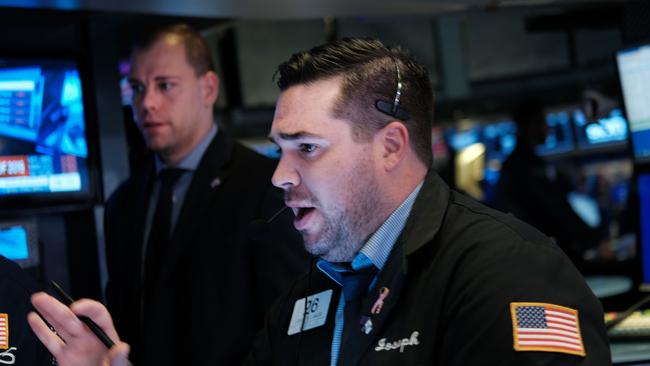
Losses were broad-based but some companies suffered especially bruising declines.
Apple, which manufactures iPhones and other goods in China, shed 5.2 per cent. Chip companies, which also import from the country,including Intel and Micron Technology lost 3.5 percent and 4.9 per cent respectively.
Retailers experienced another painful session in the wake of Trumps’ latest tariff, with Macy’s, Best Buy and Ralph Lauren all off more than three per cent.
AFP
6.37am: Iron ore dives below $US100
The spot price of iron ore slumped 8.6 per cent to $US99, according to CommSec.
6.40am: Wall St sinks on trade war fears
Wall Street’s major indexes have tumbled, with the benchmark S&P 500 dropping about 3 per cent, as a fall in the yuan following US President Donald Trump’s vow to impose additional tariffs on Chinese goods sparked fears of a further escalation of the US-China trade war.
The Dow Jones Industrial Average fell 767.27 points, or 2.9 per cent, to 25,717.74, the S&P 500 lost 87.31 points, or 2.98 per cent, to 2,844.74, and the Nasdaq Composite dropped 278.03 points, or 3.47 per cent, to 7,726.04.
After $38bn was wiped from the Australian market yesterday, local shares are tipped to plummet at the open. At 6.35am (AEST) the SPI futures index was down 107 points.
Reuters
....used currency manipulation to steal our businesses and factories, hurt our jobs, depress our workers’ wages and harm our farmers’ prices. Not anymore!
— Donald J. Trump (@realDonaldTrump) August 5, 2019
6.35am: New US media merger
Two of the US’s largest newspaper companies have agreed to combine in the latest mediadeal driven by the industry’s struggles with a decline of printed editions.
GateHouse Media, a chain backed by an investment firm, is buying USA Today owner Gannett Co. for $US12.06 a share in cash andstock, or about $US1.4 billion. The combined company would have more than 260 daily papers in the US along with more than 300 weeklies.
The companies said the deal will cut up to $US300 million in costs annually and help speed up a digital transformation.
6.30am: China firms stop buying US produce
Chinese firms have stopped purchasing US farm produce, state media said, following US President Donald Trump’s vow to put more tariffs on imports from China.
China “would temporarily not rule out the possibility of levying additional tariffs on imported US farm produce with dealsmade after August 3, and related Chinese companies have halted purchases of US farm produce,” the official Xinhua news agency quoted the National Development and Reform Commission and the Ministry of Commerce as saying.
AFP
6.27am: Global stocks tumble
World stock markets plunged Monday after the Chinese yuan fell sharply in what analysts said was Beijing’s riposte to US President Donald Trump vowing to impose fresh tariffs on Chinese goods in the latest trade war flare-up.
“Stocks are sliding after China retaliated against the latest salvo of Washington tariffs by letting the yuan weaken below seven to the dollar,” said Fawad Razaqzada at Forex.com.
Major US indices had dived by more than two per cent by the late New York morning, with the tech-heavy Nasdaq close to a three-per cent decline.
London and Paris were also more than two per cent down at the close, with Frankfurt doing only marginally better.
Earlier, there was heavy selling in Asia where Hong Kong slid nearly three per cent.
“There is a feeling that China could inflict a lot more pain on the US in terms of the trade spat, and many traders are worried the economic conflict will rumble on for some time,” said IG analyst David Madden.
Trump’s announcement would mean as that of September 1 all goods imported from China will be subject to US punitive tariffs.
AFP
6.25am: RBA expected to hold rates
The Reserve Bank looks set to hold the cash rate at 1.0 per cent ahead of data out this week that could offer clues about whether the past two months’ cuts are having an effect.
Economists expect the RBA to keep the rate unchanged at today’s board meeting before cutting to a fresh record low before the end of 2019.
The timing of that next cut, which the futures market has priced for October or November, could become clearer this week when the RBA announces its revised forecasts and the Australian Bureau of Statistics releases its new lending data for June.
Tomorrow’s release by the ABS, which includes data on mortgage lending, should give clarity about whether the first of the RBA’s two 0.25 percentage point cuts have had any stimulating effect on the key Sydney and Melbourne housing markets. Mortgage lending excluding refinancing fell by 2.4 per cent in May as housing investors kept their hands in their pockets about the time of the federal election.
AAP
6.20am: US service sector slides
The US services sector, the principal driver of American economic growth, slid last month to its slowest pace in nearly three years, according to an industry survey.
The unexpected slowdown marked the second consecutive monthly decline after months of a slowing trend. It was driven by a steep drop off in production and inventories, according to the Institute for Supply Management.
The survey did not capture reaction to the latest snap deterioration in US-China trade relations or Monday’s decline in thevalue of the Chinese yuan, which fell to its lowest level against the dollar since 2010, breaking through the key threshold of 7 to the dollar.
But the services slowing growth was likely to fuel concerns that the risk of recession are growing.
AFP
6.15am: Tesco axes 4500 jobs
British supermarket giant Tesco said it is to axe about 4500 jobs across its city-centre UK stores to slash costs.
Tesco, which is Britain’s biggest retailer, will carry out a “reduction of around 4500 colleagues” as the group experiences “an increasingly competitive and challenging retail environment”, it said in a statement.
The job cuts, equivalent to about one per cent of Tesco’s worldwide workforce, come after the company axed 9000 roles in January.
The latest job cuts will be at Tesco’s Metro stores, largely found in city and town centres across the UK.
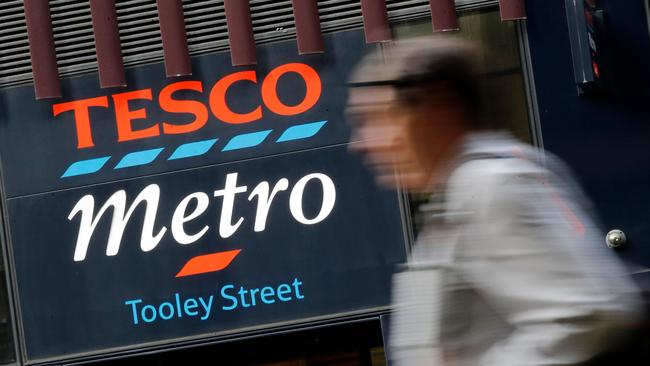
AFP
6.12am: Falling pound lifts firms
The falling pound appears to have helped Britain’s services companies pick up new business in July but the wider economy remains stagnant as the latest Brexit deadline looms into view, a closely watched survey showed.
Financial information company IHS Markit and the Chartered Institute of Procurement & Supply said their ‘all-sector’ purchasing managers’ index - a gauge of business activity across manufacturing, construction and services - rose to 50.3 points in Julyfrom 49.2 the previous month.
The increase took the index back above the 50-point threshold that separates contraction from growth. But it remains at historically low levels: with the exception of a brief decline seen in the immediate aftermath of Britain’s June 2016 vote to leave the European Union, the index has only been lower six times since the global financial crisis a decade ago.
AP
6.12am: Yuan weakest 2010
The Chinese yuan fell to its lowest level against the dollar since August 2010, fuelling speculation that Beijing is allowing currency depreciation to counter threatened US tariffs.
US President Donald Trump reacted angrily later in the day, accusing China of deliberately and improperly weakening its currency.
“China dropped the price of their currency to an almost a historic low. It’s called ‘currency manipulation.’ Are you listening Federal Reserve?” he said on Twitter, calling the change “a major violation” which would “greatly weaken China.”
The offshore currency weakened to 7.1114 to the dollar -- the worst since 2010 -- days after US President Donald Trump announced a plan to impose fresh tariffs on another $US300 billion in Chinese goods, sharpening trade war tensions between the world’s two biggest economies.
The onshore yuan also tumbled, hitting 7.0536 to reach its lowest level since 2008.
Both the onshore and offshore yuan breached the 7.0 level against the dollar for the first time in nine years, which investors see as a key threshold in currency value.
AFP
China dropped the price of their currency to an almost a historic low. It’s called “currency manipulation.†Are you listening Federal Reserve? This is a major violation which will greatly weaken China over time!
— Donald J. Trump (@realDonaldTrump) August 5, 2019
6.10am: ASX recap, market slumps
The Australian share market has suffered its biggest loss since December 10, with every sector deep in the red after signs that China is striking back against the US in their escalating trade war.
The benchmark S&P/ASX200 index finished down 128.3 points, or 1.9 per cent, to 6,640.3 points at 1615 AEST on Monday, whilethe broader All Ordinaries was down 135.5 points, or 1.98 per cent, to 6,710.6 points.
It was the S&P/ASX200’s worst loss since a 129-point, 2.3 per cent loss on December 10, 2018.
The plunge came after China let the yuan tumble to its weakest level in a decade and asked state-owned companies to suspend US agricultural imports, in apparent retaliation for US President Donald Trump’s vow to impose additional 10 per cent tariffson Chinese exports on September 1.
The Australian dollar slid 0.45 per cent to US67.71 cents, from US68.45 cents on Friday, its lowest level against the greenback since 2009.



To join the conversation, please log in. Don't have an account? Register
Join the conversation, you are commenting as Logout